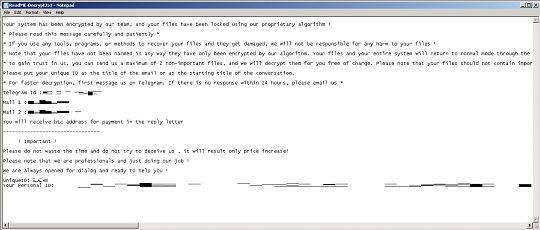Ransom.MSIL.BLCKDREAM.THJBEBC
TR/Ransom.kudwl (ANTIVIR)
Windows


Threat Type: Ransomware
Destructiveness: No
Encrypted:
In the wild: Yes
OVERVIEW
Downloaded from the Internet, Dropped by other malware
This Ransomware arrives on a system as a file dropped by other malware or as a file downloaded unknowingly by users when visiting malicious sites.
It encrypts files found in specific folders. It drops files as ransom note. It avoids encrypting files with the following file extensions.
TECHNICAL DETAILS
127,488 bytes
EXE
Yes
25 Oct 2023
Modifies system registry, Encrypts files
Arrival Details
This Ransomware arrives on a system as a file dropped by other malware or as a file downloaded unknowingly by users when visiting malicious sites.
Installation
This Ransomware adds the following processes:
- cmd.exe /c vssadmin.exe delete shadows /all /quiet → deletes shadow copies
Autostart Technique
This Ransomware modifies the following registry entries to ensure it automatic execution at every system startup:
HKEY_CURRENT_USER\SOFTWARE\Microsoft\
CurrentVersion\Run
SF = {malware path}\{malware filename}.exe
Other Details
This Ransomware does the following:
- It does not encrypt files larger than 2GB.
- It encrypts files in local, removable, and shared drives.
Ransomware Routine
This Ransomware encrypts files found in the following folders:
- %Desktop%
- %User Profile%\Favorites
- %User Profile%\Downloads
- %User Profile%\Documents
- %User Profile%\Pictures
- %User Profile%\Videos
- %User Profile%\Music
- {Available Drives}
(Note: %Desktop% is the current user's desktop, which is usually C:\Documents and Settings\{User Name}\Desktop on Windows 2000(32-bit), XP, and Server 2003(32-bit), or C:\Users\{user name}\Desktop on Windows Vista, 7, 8, 8.1, 2008(64-bit), 2012(64-bit) and 10(64-bit).. %User Profile% is the current user's profile folder, which is usually C:\Documents and Settings\{user name} on Windows 2000(32-bit), XP, and Server 2003(32-bit), or C:\Users\{user name} on Windows Vista, 7, 8, 8.1, 2008(64-bit), 2012(64-bit) and 10(64-bit).)
It avoids encrypting files with the following strings in their file name:
- ReadME-Decrypt
It avoids encrypting files found in the following folders:
- C:\Windows
It appends the following extension to the file name of the encrypted files:
- {original filename}.{original extension}.[affected system ID].[Blackdream01@zohomail.eu].BlackDream
It drops the following file(s) as ransom note:
- {available drives}\ReadME-Decrypt.txt
- %Desktop%\ReadME-Decrypt.txt

It avoids encrypting files with the following file extensions:
- .BlackDream
- .blackdream
- .Blackdream
- .blackDream
- .exe
- .dll
SOLUTION
9.800
18.778.04
25 Oct 2023
18.779.00
26 Oct 2023
Step 1
Trend Micro Predictive Machine Learning detects and blocks malware at the first sign of its existence, before it executes on your system. When enabled, your Trend Micro product detects this malware under the following machine learning name:
- TSPY.Win32.TRX.XXPE50FFF075
Step 2
Before doing any scans, Windows 7, Windows 8, Windows 8.1, and Windows 10 users must disable System Restore to allow full scanning of their computers.
Step 3
Note that not all files, folders, and registry keys and entries are installed on your computer during this malware's/spyware's/grayware's execution. This may be due to incomplete installation or other operating system conditions. If you do not find the same files/folders/registry information, please proceed to the next step.
Step 4
Restart in Safe Mode
Step 5
Delete this registry value
Important: Editing the Windows Registry incorrectly can lead to irreversible system malfunction. Please do this step only if you know how or you can ask assistance from your system administrator. Else, check this Microsoft article first before modifying your computer's registry.
- In HKEY_CURRENT_USER\SOFTWARE\Microsoft\CurrentVersion\Run
- SF = {malware path}\{malware filename}.exe
- SF = {malware path}\{malware filename}.exe
Step 6
Search and delete these files
- {available drives}\ReadME-Decrypt.txt
- %Desktop%\ReadME-Decrypt.txt
Step 7
Restart in normal mode and scan your computer with your Trend Micro product for files detected as Ransom.MSIL.BLCKDREAM.THJBEBC. If the detected files have already been cleaned, deleted, or quarantined by your Trend Micro product, no further step is required. You may opt to simply delete the quarantined files. Please check this Knowledge Base page for more information.
Step 8
Restore encrypted files from backup.
Did this description help? Tell us how we did.

